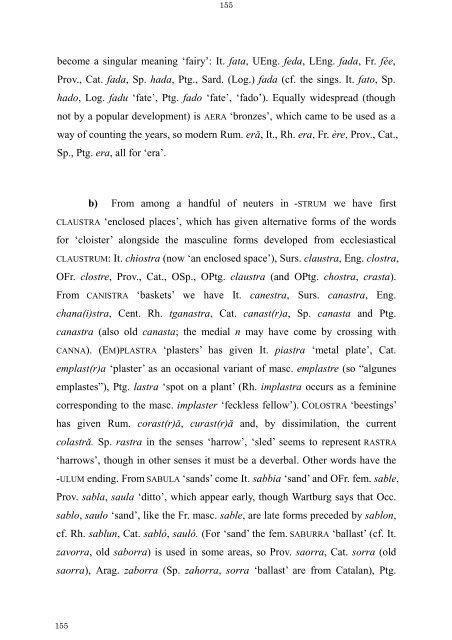The Latin Neuter Plurals in Romance - Page ON
The Latin Neuter Plurals in Romance - Page ON
The Latin Neuter Plurals in Romance - Page ON
Create successful ePaper yourself
Turn your PDF publications into a flip-book with our unique Google optimized e-Paper software.
155<br />
155<br />
become a s<strong>in</strong>gular mean<strong>in</strong>g ‘fairy’: It. fata, UEng. feda, LEng. fada, Fr. fée,<br />
Prov., Cat. fada, Sp. hada, Ptg., Sard. (Log.) fada (cf. the s<strong>in</strong>gs. It. fato, Sp.<br />
hado, Log. fadu ‘fate’, Ptg. fado ‘fate’, ‘fado’). Equally widespread (though<br />
not by a popular development) is AERA ‘bronzes’, which came to be used as a<br />
way of count<strong>in</strong>g the years, so modern Rum. eră, It., Rh. era, Fr. ère, Prov., Cat.,<br />
Sp., Ptg. era, all for ‘era’.<br />
b) From among a handful of neuters <strong>in</strong> -STRUM we have first<br />
CLAUSTRA ‘enclosed places’, which has given alternative forms of the words<br />
for ‘cloister’ alongside the mascul<strong>in</strong>e forms developed from ecclesiastical<br />
CLAUSTRUM: It. chiostra (now ‘an enclosed space’), Surs. claustra, Eng. clostra,<br />
OFr. clostre, Prov., Cat., OSp., OPtg. claustra (and OPtg. chostra, crasta).<br />
From CANISTRA ‘baskets’ we have It. canestra, Surs. canastra, Eng.<br />
chana(i)stra, Cent. Rh. tganastra, Cat. canast(r)a, Sp. canasta and Ptg.<br />
canastra (also old canasta; the medial n may have come by cross<strong>in</strong>g with<br />
CANNA). (EM)PLASTRA ‘plasters’ has given It. piastra ‘metal plate’, Cat.<br />
emplast(r)a ‘plaster’ as an occasional variant of masc. emplastre (so “algunes<br />
emplastes”), Ptg. lastra ‘spot on a plant’ (Rh. implastra occurs as a fem<strong>in</strong><strong>in</strong>e<br />
correspond<strong>in</strong>g to the masc. implaster ‘feckless fellow’). COLOSTRA ‘beest<strong>in</strong>gs’<br />
has given Rum. corast(r)ă, curast(r)ă and, by dissimilation, the current<br />
colastră. Sp. rastra <strong>in</strong> the senses ‘harrow’, ‘sled’ seems to represent RASTRA<br />
‘harrows’, though <strong>in</strong> other senses it must be a deverbal. Other words have the<br />
-ULUM end<strong>in</strong>g. From SABULA ‘sands’ come It. sabbia ‘sand’ and OFr. fem. sable,<br />
Prov. sabla, saula ‘ditto’, which appear early, though Wartburg says that Occ.<br />
sablo, saulo ‘sand’, like the Fr. masc. sable, are late forms preceded by sablon,<br />
cf. Rh. sablun, Cat. sabló, sauló. (For ‘sand’ the fem. SABURRA ‘ballast’ (cf. It.<br />
zavorra, old saborra) is used <strong>in</strong> some areas, so Prov. saorra, Cat. sorra (old<br />
saorra), Arag. zaborra (Sp. zahorra, sorra ‘ballast’ are from Catalan), Ptg.









